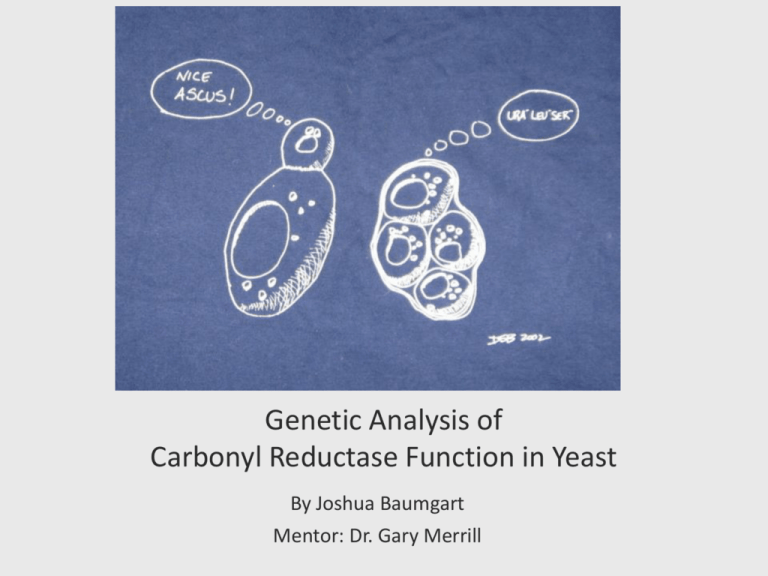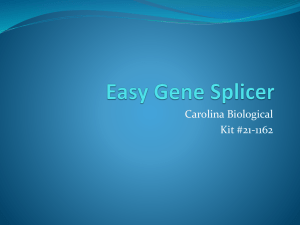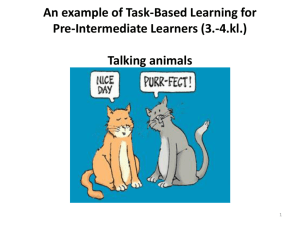Genetic and Biochemical Analysis of a Protein Family Affecting
advertisement

Genetic Analysis of Carbonyl Reductase Function in Yeast By Joshua Baumgart Mentor: Dr. Gary Merrill Carbonyl reductase Carbonyl reductase is an enzyme that reduces carbonyls (aldehydes and ketones) to their corresponding alcohols The reaction requires a reducing agent called NADPH (NADPH is produced in all cells and represents “reducing power” NADPH NADPH Relevance Accumulation of carbonyl-containing compounds is potentially toxic to cells Sources of carbonyl-containing compounds include: External agents such as cigarette smoke, pollution, and automobile exhaust (which can lead to cancer) Internal agents such as lipid breakdown products and intermediary metabolites Saccharomyces cerevisiae Advantages of yeast as an experimental system Grows rapidly (1.8 hour doubling time) Can be maintained as haploid or diploid Easy to delete, add, or replace genes Genome completely sequenced (6022 genes) Gene deletion project (about 1500 genes are essential) Yeast contain ten genes with sequence similarity to mammalian carbonyl reductase Individual deletion of any one of the ten yeast genes does not result in lethality Ten yeast carbonyl reductase (CBR) genes Gene knockouts (SGD nomenclature) My nomenclature △yir035c:Kan △yir036c:Kan △ykr009c:Kan △ykl071w:Kan △yor246c:Kan △ydl114w:Kan △yil124w:Kan △ymr226c:Kan △ylr426w:kan △ykl055c:Kan △cbr1 △cbr 2 △cbr 3 △cbr 4 △cbr 5 △cbr 6 △cbr 7 △cbr 8 △cbr 9 △cbr 10 Library genotype The library version of the genes obtained through the Saccharomyces Genome Database has the following genotype: Mat-α ura3 leu2 lys2 his3 MET15 yfg:KAN The mutant that we used in the mating with the library to achieve a triple mutants was obtained through work done by Sarah Kerrigan summer research 2012 with the following genotype: Mat-a ura3 leu2 lys2 his3 met15 △cbr1/△cbr2:HIS3 Diploid genotype During Winter and Spring term 2013, Merrill’s lab mated the remaining eight △cbr genes to the △cbr1/ △cbr2 double mutant created by Sarah Kerrigan creating the following genotype: Mat-a △cbr1 △cbr2:HIS3 CBR3 Mat-α CBR1 CBR2 △cbr3:KAN Random spore analysis Rich medium Defined medium with kanamycin Defined medium missing histadine Defined medium missing methionine Expected band (bp) 5 6 723 723 462 △8:KAN (neg control) 4 △1,2:HIS △8:KAN 3 △1,2:HIS △7:KAN 2 △ 1,2:HIS (pos control) △1,2:HIS △8:KAN CBR7/KAN △7:KAN (neg control) △8:KAN (pos control) 1 △8:KAN (neg control) Template △1,2:HIS △7:KAN Primers △7:KAN (pos control) Direct genotyping by PCR CBR8/KAN 462 - CBR2/HIS 7 8 9 10 11 865 865 865 - Triple mutant genotype From the random spore analysis I determined that a triple mutant missing △cbr1, △cbr2, and △cbr3 does not result in lethality created by the following genotype: Mat-a △cbr1/△cbr2:HIS3 △cbr3:KAN Merrill lab proved that a triple mutant created by the cross from Sarah Kerrigan’s double mutant and any one of the eight library mutants will not produce a lethality Summer project Triple mutants lacking △cbr1, △cbr2, and one of the other eight Cbr genes were all viable Create quadruple mutants missing △cbr1, △cbr2, △cbr3, and one of the other seven Cbr genes Determine whether any of the quadruple mutants are inviable (produce synthetic lethality) Approach 1. Replace △cbr3:KAN gene with △cbr3:LEU2 gene Mat-a △cbr1/△cbr2:HIS3 △cbr3:KAN Mat-a △cbr1/△cbr2:HIS3 △cbr3:LEU2 2. Make diploid by mating new mat-a triple mutant to mat-α library mutants mat-a △cbr1/△cbr2:HIS3 △cbr3:LEU2 mat-α CBR1 CBR2 CBR3 CBR4 △cbr4:KAN 3. Sporulate diploid, isolate random segregates, determine whether quadruple mutant is viable 1. Replacing △cbr3:KAN gene with △cbr3:LEU2 gene Prepared a LEU2 marker with KAN flanking sequences by PCR LEU2 pRS305 KAN5’ LEU2 KAN3’ Transformed △cbr1,2:HIS3 △cbr3:KAN strain with LEU2 fragment Selected transformants on medium lacking leucine CBR3 KAN KAN LEU2 LEU2 Template Expected band (bp) 1 △ 1,2:HIS △3:LEU #8 3 4 5 1kb 1kb 1kb 1kb 1kb 1kb 1kb 1kb 1kb △3:KAN (neg control) △ 1,2:HIS △3:LEU #9 △ 1,2:HIS △3:LEU #7 △ 1,2:HIS △3:LEU #5 △ 1,2:HIS △3:LEU #4 △ 1,2:HIS △3:LEU #3 Primers △ 1,2:HIS △3:LEU #6 2 △ 1,2:HIS △3:LEU #2 △ 1,2:HIS △3:LEU #1 Direct genotyping by PCR CBR2/LEU - 2. Make diploid After confirming transformation maker conversion, I mated triple mutant to each of the seven remaining △cbr:KAN single mutants For example, mating to △cbr4:KAN is expected to give a diploid with the following genotype: Mat-a △cbr1/△cbr2:HIS3 △cbr3:LEU2 CBR4 Mat-α CBR1 CBR2 CBR3 △cbr4:KAN 3. Sporulate diploid Transferred diploid to nutrient-deficient plates to induce sporulation Isolated spores by ether treatment Plated spores at low dilution on rich medium to induce germination Picked random colonies to micro-titer wells Replicaplated micro-titer dish to selective conditions Random spore analysis Rich medium Defined medium missing histadine Defined medium with kanamycin Defined medium missing Leucine Summary I converted the△cbr1,2:HIS3 △cbr3:KAN triple mutant to a △cbr1,2:HIS3 △cbr3:LEU2 triple mutant I mated the new triple mutant to seven single mutants to derive diploids I analyzed the diploids by random spore analysis and determined that all seven quadruple mutants were viable (no synthetic lethality) I confirmed the genotype of all derived strains by PCR The genotype of the quadruple mutant is: Mat-a △cbr1/△cbr2:HIS3 △cbr3:LEU2 △cbr:KAN Results △cbr4 and △cbr5 is a confirmed transformant for the LEU2 gene integration I have successfully moved △cbr6-8 to the transformation step. Future research direction Continue the process of homologously integrating the LEU2 gene into △cbr6-8 to verify that any quadruple mutant made by the other Cbr genes would not result in lethality. If no quadruple mutants show synthetic lethality, knockout a fifth gene creating a quintuple mutant to see if any new combination would result in a lethality. Acknowledgments Dr. Gary Merrill Ray, Frances, and Dale Cripps Scholarship fund Dr. Kevin Ahern Oregon State University Undergraduate Summer Research Program Merrill lab Jason Mah Thi Nguyen




